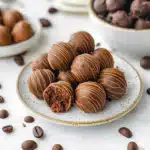Tired of toppings that melt into a soggy mess or never quite hit that sweet spot of buttery crunch? You’re not alone. Many bakers struggle with streusel that turns pasty or falls flat in texture. The good news is, there’s a reliable fix. This guide reveals the best way to make streusel topping that’s crisp, crumbly, and full of flavor.
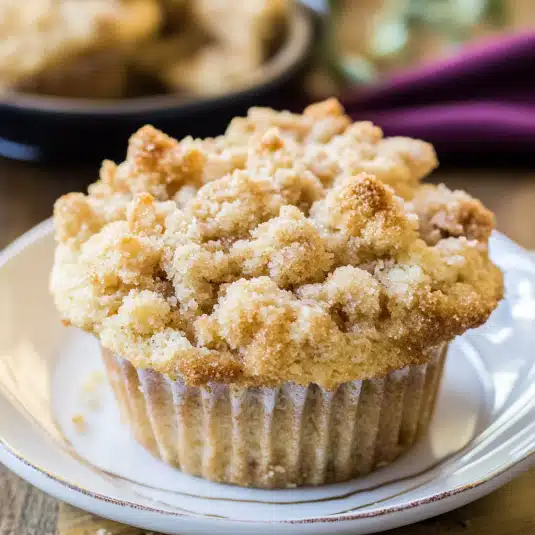
Whether you’re topping muffins, pies, or coffee cakes, this recipe gives you the flexibility to choose the butter method that works best for you. From soft and tender to chunky and crisp, the perfect texture is within reach. This article covers everything you need to master streusel topping, no matter your skill level.
Table of Contents
Why This Streusel Topping Recipe Stands Out
You’ve seen crumb toppings before, but this one goes beyond the basics. Here’s why it’s better than the rest:
- Foolproof Results: Covers all three butter techniques so you can choose your ideal texture.
- Fast and Simple: Ready in under ten minutes with ingredients you already have.
- Fully Customizable: Easily add oats, nuts, or your favorite spices without changing the base recipe.
- Tested for Consistency: Every version has been tried and perfected so you know exactly what to expect.
- Clear Visual Guide: Includes texture comparisons and a troubleshooting table to fix common mistakes fast.
This isn’t just another topping. It’s your go-to guide for getting it right every time.
Ingredient Deep-Dive: What Each Element Does
Understanding your ingredients is the key to perfecting your streusel topping. Here’s how each one works to create that crumbly, buttery finish.
- All-Purpose Flour (1¼ cup or 150g)
This forms the base of the topping. It binds everything together and gives structure to the crumbs. - Light Brown Sugar (½ cup packed or 110g)
Adds moisture and a mild molasses flavor. It helps the streusel clump into those satisfying sweet nuggets. - Granulated Sugar (¼ cup or 50g)
Brings crispness and balances the deeper flavor of the brown sugar with a clean, sweet note. - Ground Cinnamon (1½ teaspoons)
Provides warm spice and depth. You can adjust this or swap it for other spices like nutmeg or cardamom. - Salt (¼ teaspoon)
Enhances all the flavors and prevents the topping from tasting flat or overly sweet. - Unsalted Butter, Melted and Cooled (½ cup or 113g)
The glue that holds everything together. It also creates richness and helps the mixture brown beautifully during baking. Letting it cool slightly before mixing is key to getting clumps instead of paste.
These ingredients work together to give you a streusel that’s balanced in flavor, texture, and sweetness.
The Great Butter Debate: Which Method Is Best?
Butter isn’t just an ingredient in streusel. It’s the variable that changes everything. Depending on its temperature and texture, you get completely different results. Here’s how each method works and what kind of topping it produces.
Melted Butter
Method: Pour melted and slightly cooled butter into the dry ingredients. Stir with a fork until clumps form.
Texture: Dense and moist with fine crumbs. Clumps are smaller and more uniform.
Best For: Quick breads, coffee cakes, or recipes where the streusel is partially absorbed into the batter.
Cold Butter (Cut-In Method)
Method: Use a pastry cutter, fork, or your fingers to cut small chunks of cold butter into the dry mix until it looks like coarse sand with small lumps.
Texture: Chunky, airy crumbs with great structure. Crumbs stay intact during baking.
Best For: Muffins, pies, and fruit crisps where you want a well-defined crumb on top.
Soft Butter (Creamed Method)
Method: Cream soft room-temperature butter with the sugars first, then stir in the dry ingredients.
Texture: Tender and rich. The crumbs are softer and more delicate.
Best For: Cakes and softer pastries where you want a melt-in-your-mouth topping.
Butter Comparison Table
| Butter Type | Final Texture | Best Used For |
| Melted | Moist, fine crumbs | Quick breads, coffee cakes |
| Cold (Cut-In) | Chunky, firm crumbs | Muffins, pies, fruit crisps |
| Soft (Creamed) | Tender, soft crumbs | Cakes and delicate pastries |
No single method is “better” than the others. It all depends on what texture you’re aiming for. Try each one and see which fits your style best.
How to Make Streusel Topping
Follow these clear steps to create a perfect streusel topping every time. This version uses melted butter for ease and speed, but you can swap in cold or soft butter depending on your preference.
- Measure and combine dry ingredients
In a medium mixing bowl, add the flour, brown sugar, granulated sugar, cinnamon, and salt. Stir well with a fork or whisk to break up any lumps and blend the ingredients evenly. This sets the foundation for balanced flavor and texture. - Add the butter
Slowly pour in the melted and slightly cooled butter. Make sure it is not hot, as that can cause the mixture to become greasy instead of crumbly. - Mix gently until crumbs form
Using a fork, stir the mixture just until large, moist clumps appear. Avoid overmixing. The goal is to create crumbly chunks, not a paste. If the mixture looks dry at first, keep stirring gently until all the flour is coated. - Chill the streusel
Place the bowl in the refrigerator while you prepare the rest of your recipe. Chilling helps the crumbs firm up and hold their shape when baked. Ten to fifteen minutes is usually enough.
Now your streusel is ready to top muffins, cakes, pies, or any dessert that needs a sweet, buttery crunch.
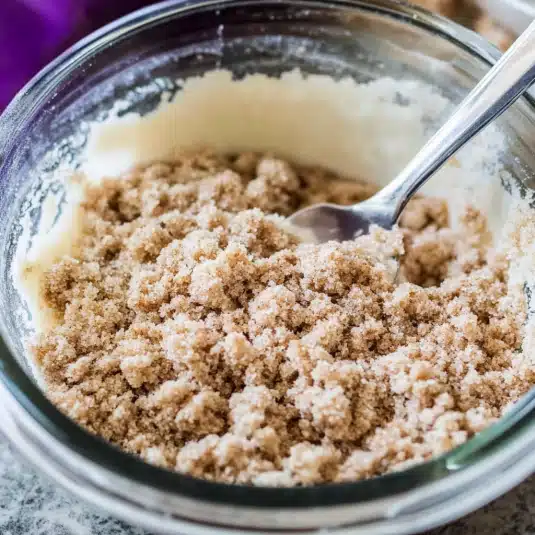
Pro Tips for Success
Use these quick tips to avoid common mistakes and get the perfect crumbly topping every time.
- Cool the melted butter before mixing so it doesn’t create a greasy paste.
- Don’t overmix the dough. Stir just until the crumbs hold together.
- Use a fork instead of a spoon to mix. It creates better clumps and prevents overworking the dough.
- Chill the topping before baking to help the crumbs keep their shape in the oven.
- Double the batch and freeze half for later. Streusel freezes well and makes future baking faster.
- Adjust the sugar balance if your dessert is already sweet. You can slightly reduce the sugar without affecting texture.
- Use fresh spices for stronger flavor. Cinnamon loses its punch if it’s been sitting in your pantry for too long.
Variations and Customizations
Streusel is flexible and easy to adjust based on your preferences or dietary needs. Here’s how to make it your own.
How to Add Nuts or Oats
- Nuts: Add up to half a cup of chopped pecans, walnuts, or almonds for extra crunch. Toast them first for deeper flavor.
- Oats: Stir in a quarter to half a cup of old-fashioned rolled oats. They add a hearty texture and a rustic look.
Spiced Streusel Variations
- Cinnamon Lovers: Increase the cinnamon to two teaspoons for a stronger spice kick.
- Mixed Spices: Try adding a pinch of nutmeg, ginger, or cardamom for a warm twist.
- Cocoa Streusel: Replace two tablespoons of flour with unsweetened cocoa powder for a chocolate version.
How to Make It Gluten-Free
- Use a one-to-one gluten-free flour blend that contains xanthan gum. This helps keep the structure similar to regular flour.
- Double check your oats if using. Choose certified gluten-free oats to avoid cross-contamination.
How to Make It Dairy-Free or Vegan
- Replace the butter with a plant-based butter stick. Avoid soft tub-style spreads as they usually contain more water and may affect texture.
- Check that your sugars are vegan, as some brands process white sugar with bone char.
These small tweaks can completely change the flavor and texture of your streusel, letting you match it to any recipe or dietary preference.
Unique Use-Cases for Streusel Topping
Streusel isn’t just for baking on top of muffins or pies. Here are two creative ways to use it that go beyond the usual.
How to Bake Streusel by Itself (For a Crunchy Topping)
Baking streusel on its own lets you use it as a crispy topping for ice cream, yogurt, or fruit.
- Preheat your oven to 350°F (175°C).
- Spread the prepared streusel evenly on a parchment-lined baking sheet.
- Bake for eight to twelve minutes, stirring once halfway through. Watch closely near the end so it doesn’t burn.
- Let it cool completely before using. It will crisp up as it cools.
- Store in an airtight container at room temperature for up to five days.
This method gives you golden, crunchy clusters ready to sprinkle on anything.
How to Make No-Bake Streusel (Safely)
Want to use streusel on cold desserts like ice cream or parfaits but don’t want to turn on the oven? Here’s a stovetop version that’s safe to eat.
- Toast the flour in a dry pan over medium heat for five to seven minutes. Stir often to avoid burning. This removes any raw flour taste and makes it safe to eat.
- Let the flour cool, then mix with the sugars, cinnamon, and salt.
- Stir in soft butter instead of melted or cold. This will help the mixture stick together slightly without baking.
- Store the no-bake streusel in the fridge for up to one week.
This version works great for no-bake cheesecakes, yogurt bowls, or fruit salads.
Troubleshooting Guide
If your streusel didn’t turn out the way you hoped, don’t worry. Here’s a quick guide to common issues, what caused them, and how to fix them fast.
| Problem | Likely Cause | Quick Fix |
| Streusel turned into a paste | Butter was too hot | Let the butter cool longer before mixing |
| Topping feels greasy | Too much butter or overmixed | Use exact measurements and stir gently |
| Streusel is dry and floury | Not enough butter or under mixed | Mix a little more or add a spoonful of melted butter |
| Crumbs melted into the batter | Butter was too soft or topping too warm | Chill the streusel before baking |
| Topping didn’t brown | Oven temperature was too low | Increase temperature slightly or bake longer |
| Crumbs are too small | Overmixed or not enough fat | Use cold butter and cut in gently for larger crumbs |
This table helps you diagnose problems at a glance and fix them without guessing. The more you use it, the easier perfect streusel becomes.
Storage Instructions
Keeping your streusel fresh depends on whether it’s baked or unbaked. Here’s how to store both properly.
Unbaked Streusel
- Refrigerator: Store in an airtight container for up to three days. Keep it cold to maintain the crumb structure.
- Freezer: Spread the streusel on a baking sheet and freeze until solid. Transfer to a sealed bag or container. It will keep for up to three months. Use straight from the freezer without thawing.
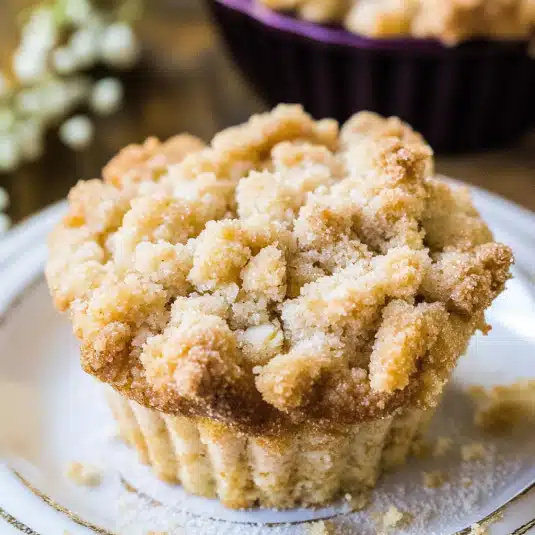
Baked Streusel
- Room Temperature: Store in an airtight container for up to five days. Make sure it’s fully cooled before sealing to avoid moisture buildup.
- Freezer: Freeze baked streusel in a single layer, then transfer to a container. Re-crisp in the oven at 300°F (150°C) for five to ten minutes before serving.
Proper storage keeps your streusel crisp and ready to go whenever you need it.
Print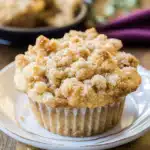
Streusel Topping
- Total Time: 22 minutes
- Yield: 8 1x
- Diet: Vegetarian
Description
This buttery, crumbly streusel topping adds the perfect crunch to muffins, pies, and cakes. Made with simple ingredients and customizable add-ins, it’s ready in minutes and easy to master.
Ingredients
- 1¼ cup (150g) all-purpose flour
- ½ cup packed (110g) light brown sugar
- ¼ cup (50g) granulated sugar
- 1½ teaspoons ground cinnamon
- ¼ teaspoon salt
- ½ cup (113g) unsalted butter, melted and cooled
Instructions
- In a medium mixing bowl, combine flour, brown sugar, granulated sugar, cinnamon, and salt. Stir well with a fork or whisk.
- Slowly pour in the melted and slightly cooled butter.
- Using a fork, stir the mixture just until large, moist clumps appear. Avoid overmixing.
- Chill the streusel in the refrigerator for 10–15 minutes to help crumbs firm up.
Notes
Cool the butter before mixing. Stir gently with a fork for perfect crumbs. Chill before baking to keep the shape. Add nuts, oats, or spices for variation.
- Prep Time: 10 minutes
- Cook Time: 12 minutes
- Category: Topping
- Method: Baking or No-Bake
- Cuisine: American
Nutrition
- Serving Size: 1 serving
- Calories: 154 kcal
- Sugar: 79g
- Sodium: 314mg
- Fat: 47g
- Saturated Fat: 29g
- Unsaturated Fat: 14g
- Trans Fat: 2g
- Carbohydrates: 140g
- Fiber: 3g
- Protein: 9g
- Cholesterol: 122mg
Final Thoughts and Your Turn
You now have every tool you need to make a perfect streusel topping from scratch. From understanding each ingredient’s role to mastering different butter techniques, this guide walks you through every step with clarity and confidence. Whether you’re baking muffins, pies, or looking for a crunchy topping for your yogurt, this recipe adapts to your needs.
Which butter method gave you the texture you love most? Let us know in the comments below and share your favorite way to use streusel.
FAQs
What is the difference between streusel and crumble?
Streusel is a topping made from flour, sugar, and butter, often flavored with cinnamon or nuts. Crumble usually refers to a dessert, like fruit crumble, where a streusel-style topping is baked over fruit. The terms are often used interchangeably, but crumble can sometimes include oats or be a bit chunkier in texture.
Why did my streusel layer sink?
If the streusel sinks, it’s often because the batter underneath was too thin or too warm. Make sure the batter is thick enough to support the topping and chill the streusel before adding it to help keep it in place during baking.
How do I keep the streusel layer crisp?
To keep streusel crisp, make sure it is well chilled before baking. Bake at the right temperature and avoid covering it after baking, which traps steam and softens the topping. You can also briefly reheat it in the oven to revive the crunch.
How long does streusel last in the refrigerator?
Unbaked streusel can be kept in the fridge for up to three days. Make sure it’s in an airtight container to prevent it from drying out or absorbing other odors from your fridge.
Can I freeze the streusel layer?
Yes, streusel freezes very well. Spread it out on a tray, freeze until solid, then transfer to a freezer-safe bag or container. It can be baked straight from the freezer without thawing.
Is it permissible to eat raw streusel?
Standard streusel contains raw flour, which should not be eaten without cooking. If you want to use streusel as a raw topping, like on ice cream, toast the flour in a dry skillet first for safety. Let it cool before mixing with the other ingredients.




